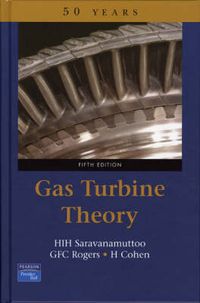
Gas Turbine Theory Upplaga 5
This is the 50th Anniversary edition of this established title. This text places the theory of gas turbines in the context of the practical realities facing aerospace, mechanical, and industrial designers. There is a strong emphasis on describing the physical reasons for solutions to design problems using practical examples. When the First Edition of this book was written in 1951, the gas turbine was just becoming established as a powerplant for military aircraft. It took another decade before the gas turbine was introduced to civil aircraft, and this market developed so rapidly that the ocean liner was rendered obsolete. Other markets like naval propulsion, pipeline compression and electrical power applications grew steadily. In recent years the gas turbine, in combination with the steam turbine, has played an ever-increasing role in power generation. Despite the rapid advances in both output and efficiency, the basic theory of the gas turbine has remained unchanged. The layout of this new fifth edition is broadly similar to the original, but greatly expanded and updated, comprising an outline of the basic theory, aerodynamic design of individual components, and the prediction of off-design performance. Descriptions of engine developments and current markets make this book useful to both students and practising engineers. (Pearson)
Upplaga: 5e upplagan
Utgiven: 2001
ISBN: 9780130158475
Förlag: Prentice Hall
Format: Inbunden
Språk: Engelska
Sidor: 512 st
This is the 50th Anniversary edition of this established title. This text places the theory of gas turbines in the context of the practical realities facing aerospace, mechanical, and industrial designers. There is a strong emphasis on describing the physical reasons for solutions to design problems using practical examples. When the First Edition of this book was written in 1951, the gas turbine was just becoming established as a powerplant for military aircraft. It took another decade before the gas turbine was introduced to civil aircraft, and this market developed so rapidly that the ocean liner was rendered obsolete. Other markets like naval propulsion, pipeline compression and electrical power applications grew steadily. In recent years the gas turbine, in combination with the steam turbine, has played an ever-increasing role in power generation. Despite the rapid advances in both output and efficiency, the basic theory of the gas turbine has remained unchanged. The layout of this new fifth edition is broadly similar to the original, but greatly expanded and updated, comprising an outline of the basic theory, aerodynamic design of individual components, and the prediction of off-design performance. Descriptions of engine developments and current markets make this book useful to both students and practising engineers. (Pearson)
Begagnad bok (0 st)
Varje vecka tillkommer tusentals nya säljare. Bevaka boken så får du meddelande när den finns tillgänglig igen.



